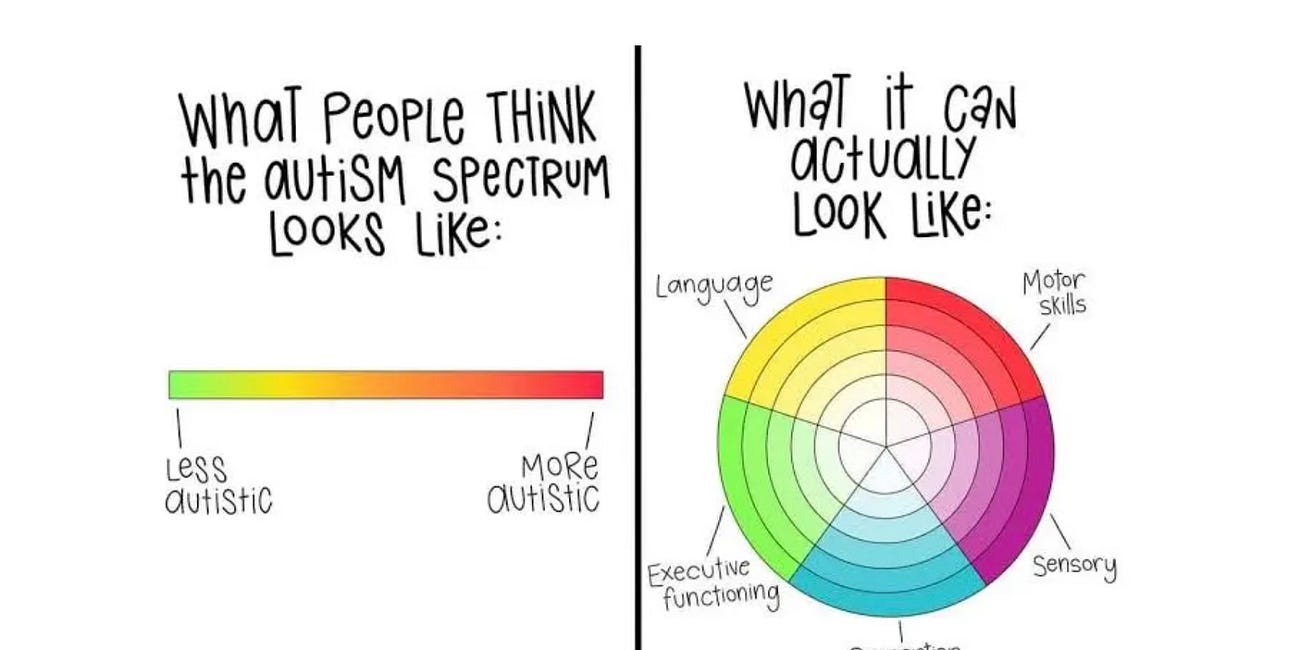Trigger warning: this post is entirely written on the topic of preventing autistic suicidality and self-harm. If you are sensitive to these topics, please take extra care of yourself.
💕
Hi Team Auti Peri!
Sorry for the bleak post but some of us in the community are on a real low. Naturally, this has led to us sharing cat photos in The Autistic Perimenopause chat group.

We need and deserve more than just autism awareness. We need a collective social movement to prolong our lives to the same life expectancy of our non-autistic peers.
This morning I watched an Autistica webinar on the topic of suicide prevention for the autistic population.
Did you know that autistic women are 13 times more likely than non-autistic women to die by suicide? I didn’t, but I learnt this in the second webinar I watched.
And I had previously thought that the “3x more likely” statistic was most up to date...
If you are feeling suicidal, or have strong feelings and urges to self-harm, please know that you are not alone. Many of us also feel that way, and we all need to support each other through this.
Hiding these feelings doesn’t help anyone, but expressing them to others and following a safety plan can save our lives.
Autistics deserve to live as long, happily and healthily as anyone else, so let’s work on suicide prevention together.
In this video post I will take you through the seven steps of the Autism Adapted Suicide Safety Plan (AASP) using this document developed by Newcastle University in the UK. 🎥

In the previous post shared below, I outlined 10 tips to support you, with the AASP being the tenth tip:
Autism Adapted Suicide Safety Plan
Reach out for help, and have an Autism Adapted Safety Plan (AASP) in place:
The resources are suggestions to help you understand and complete the safety plan for yourself, or to support another person to complete their safety plan.
Step 1 - What are my warning signs that I may start to have strong thoughts, feelings or urges to hurt myself and/or end my life? (e.g., reduced enjoyment in a strong interest, change in routine, change in patterns of sleep, eating, mood)
Step 2 - What can I do to help distract myself? (e.g., engage in a particular activity or interest, a relaxation technique, or physical activity)
Step 3 - People I can contact to ask for help: (e.g., family, friends, mentor, support worker). Remember to note down when people are, or are not, available (e.g., office hours).
Step 4 - Professionals or agencies I can contact during a crisis: (e.g., Samaritans, Mind, A & E, Psychiatric Services). Remember to note down when people are, or are not, available (e.g., opening hours).
Step 5 - What can I do to make the environment around myself safer? (e.g., throwing away things that could be used to harm yourself)
Step 6 - How can other people help support me?
How do I communicate distress? (e.g., I shut down, I have a meltdown)
What stresses me/makes me unhappy? (e.g., loud noises, being touched, change of plan, too much information)
What can help calm me/makes me happy? (e.g., a strong interest, a quiet safe place to calm down, just sitting with me, giving me my own space)
How I would like you to communicate with me? (e.g., don’t ask me to look you in the eye, speak softly, use visual supports, use plain English, keep in mind that I may take what you say literally)
Who I would like you to contact?
Step 7 – Sharing my safety plan: It can be helpful to share your safety plan. This might be with a trusted friend or family member, health care professional, or support worker. Would you like to share your safety plan? Who would you like to share it with?
Storing my safety plan: It can be helpful to think about where you will keep your safety plan so that you can easily access it if you need it (e.g., printed out, in my bag, in a ‘crisis box’, on my phone). It might also be useful to think of any prompts that could help you to remember to use your plan (e.g., having a card with the safety planning logo in it in your wallet to remind you that you have a safety plan).
I really hope this video is helpful to you! Please let me know what you think in the comments.
To fulfil your accessibility preferences, you can listen to the podcast episode rather than watch the video, and/or read the video transcript within this post. 🎧
Please take good care of yourself.
🐈 🐈⬛ 🐈 🐈⬛ 🐈 🐈⬛ 🐈















Share this post